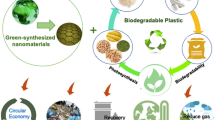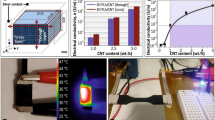Abstract
In the present study, carbon nanotubes (CNTs)–silver nanoparticles (AgNPs)-co-doped polylactic acid (PLA) nanocomposites were prepared through two-solvent-assisted method. The morphology and structure of the prepared nanocomposites were characterized, and the thermal, mechanical and antibacterial properties of the nanocomposites were tested afterward. The results indicated that the CNTs and AgNPs were well dispersed within the PLA matrix, in which the CNTs and AgNPs attached with each other. The incorporation of these two reinforcement fillers significantly enhanced the thermal stability of the PLA. Due to strong intermolecular interactions, the CNTs and AgNPs improved the tensile strength of the PLA. Additionally, the prepared nanocomposites showed promising antibacterial effect on staphylococcus haemolyticus due to the existence of AgNPs. Having improved thermal and mechanical properties, as well as antibacterial capability, the prepared PLA nanocomposites have the application potential in packaging areas.








Similar content being viewed by others
References
Yue Y, Han J, Han G, Aita GM, Wu Q (2015) Cellulose fibers isolated from energycane bagasse using alkaline and sodium chlorite treatments: structural, chemical and thermal properties. Ind Crops Prod 76:355
Yoon OJ, Jung CY, Sohn IY, Kim HJ, Hong B, Jhon MS, Lee N-E (2011) Nanocomposite nanofibers of poly (D, L-lactic-co-glycolic acid) and graphene oxide nanosheets. Compos A Appl Sci Manuf 42:1978
Yin Y, Zhao L, Jiang X, Wang H, Gao W (2018) Cellulose nanocrystals modified with a triazine derivative and their reinforcement of poly (lactic acid)-based bionanocomposites. Cellulose 25:2965
Mao D, Li Q, Li D, Chen Y, Chen X, Xu X (2018) Fabrication of 3D porous poly (lactic acid)-based composite scaffolds with tunable biodegradation for bone tissue engineering. Mater Des 142:1
Tham CY, Chow WS (2018) Hydroxyapatite coated poly (lactic acid) microparticles with copper ion doping prepared via the Pickering emulsion route. Colloid Polym Sci 296:1491
Wei XF, Bao RY, Cao ZQ, Zhang LQ, Liu ZY, Yang W, Xie BH, Yang MB (2014) Greatly accelerated crystallization of poly (lactic acid): cooperative effect of stereocomplex crystallites and polyethylene glycol. Colloid Polym Sci 292:163
Liu L, Zachariah MR, Stoliarov SI, Li J (2015) Enhanced thermal decomposition kinetics of poly (lactic acid) sacrificial polymer catalyzed by metal oxide nanoparticles. RSC Adv 5:101745
Bauhofer W, Kovacs JZ (2009) A review and analysis of electrical percolation in carbon nanotube polymer composites. Compos Sci Technol 69:1486
Shang SM, Gan L, Yuen MCW, Jiang SX, Luo NM (2014) Carbon nanotubes based high temperature vulcanized silicone rubber nanocomposite with excellent elasticity and electrical properties. Compos A Appl Sci Manuf 66:135
Rodrigues BVM, Razzino CA, de Carvalho Oliveira F, Marciano FR, Lobo AO (2017) On the design and properties of scaffolds based on vertically aligned carbon nanotubes transferred onto electrospun poly (lactic acid) fibers. Mater Des 127:183
Mai F, Habibi Y, Raquez J-M, Dubois P, Feller J-F, Peijs T, Bilotti E (2013) Poly (lactic acid)/carbon nanotube nanocomposites with integrated degradation sensing. Polymer 54:6818
Wang L, Qiu J, Sakai E, Wei X (2016) The relationship between microstructure and mechanical properties of carbon nanotubes/polylactic acid nanocomposites prepared by twin-screw extrusion. Compos A Appl Sci Manuf 89:18
Calamak S, Aksoy EA, Ertas N, Erdogdu C, Sagıroglu M, Ulubayram K (2015) Ag/silk fibroin nanofibers: effect of fibroin morphology on Ag+ release and antibacterial activity. Eur Polym J 67:99
Fouda MMG, El-Aassar MR, El Fawal GF, Hafez EE, Masry SHD, Abdel-Megeed A (2015) k-Carrageenan/poly vinyl pyrollidone/polyethylene glycol/silver nanoparticles film for biomedical application. Int J Biol Macromol 74:179
Hebeish A, El-Naggar ME, Fouda MMG, Ramadan MA, Al-Deyab SS, El-Rafie MH (2011) Highly effective antibacterial textiles containing green synthesized silver nanoparticles. Carbohydr Polym 86:936
Yin X, Wen Y, Li Y, Liu P, Li Z, Shi Y, Lan J, Guo R, Tan L (2018) Facile fabrication of sandwich structural membrane with a hydrogel nanofibrous mat as inner layer for wound dressing application. Front Chem 6:490
Dahlous KA, Abd-Elkader OH, Fouda MMG, Al Othman Z, El-Faham A (2019) Eco-friendly method for silver nanoparticles immobilized decorated silica: synthesis and characterization and preliminary antibacterial activity. J Taiwan Inst Chem Eng 95:324
Aziz A, Lim HN, Girei SH, Yaacob MH, Mahdi MA, Huang NM, Pandikumar A (2015) Silver/graphene nanocomposite-modified optical fiber sensor platform for ethanol detection in water medium. Sens Actuators B Chem 206:119
Wang M, Pramoda KP, Goh SH (2006) Enhancement of interfacial adhesion and dynamic mechanical properties of poly (methyl methacrylate)/multiwalled carbon nanotube composites with amine-terminated poly (ethylene oxide). Carbon 44:613
Chen X, Kalish J, Hsu SL (2011) Structure evolution of α′‐phase poly (lactic acid). J Polym Sci Part B Polym Phys 49:1446
Gan L, Shang SM, Yuen CWM, Jiang SX, Luo NM (2015) Facile preparation of graphene nanoribbon filled silicone rubber nanocomposite with improved thermal and mechanical properties. Compos B Eng 69:237
Banerjee S, Kahn MGC, Wong SS (2003) Rational chemical strategies for carbon nanotube functionalization. Chem A Eur J 9:1899
Shang SM, Gan L, Yuen CWM, Jiang SX, Luo NM (2015) The synthesis of graphene nanoribbon and its reinforcing effect on poly (vinyl alcohol). Compos A Appl Sci Manuf 68:149
Kister G, Cassanas G, Vert M (1998) Effects of morphology, conformation and configuration on the IR and Raman spectra of various poly (lactic acid)s. Polymer 39:267
Geng AB, Meng L, Han JQ, Zhong Q, Li MR, Han SG, Mei CT, Xu LJ, Tan L, Gan L (2018) Highly efficient visible-light photocatalyst based on cellulose derived carbon nanofiber/BiOBr composites. Cellulose 25:4133
Gan L, Geng A, Xu L, Chen M, Wang L, Liu J, Han S, Mei C, Zhong Q (2018) The fabrication of bio-renewable and recyclable cellulose based carbon microspheres incorporated by CoFe2O4 and the photocatalytic properties. J Clean Prod 196:594
Jing M, Che J, Xu S, Liu Z, Fu Q (2018) The effect of surface modification of glass fiber on the performance of poly (lactic acid) composites: graphene oxide versus silane coupling agents. Appl Surf Sci 435:1046
Hu C, Li Z, Wang Y, Gao J, Dai K, Zheng G, Liu C, Shen C, Song H, Guo Z (2017) Comparative assessment of the strain-sensing behaviors of polylactic acid nanocomposites: reduced graphene oxide or carbon nanotubes. J Mater Chem C 5:2318
Vimberg V, Cavanagh JP, Benada O, Kofroňová O, Hjerde E, Zieglerová L, Balíková Novotná G (2018) Teicoplanin resistance in Staphylococcus haemolyticus is associated with mutations in histidine kinases VraS and WalK. Diagn Microbiol Infect Dis 90:233
Acknowledgements
This work was supported by Natural Science Foundation of Jiangsu Province, China (BK20160938), Natural Science Foundation of China (51708297) and Scientific Research Foundation for High-level Talents of Nanjing Forestry University (GXL2016021).
Author information
Authors and Affiliations
Corresponding authors
Additional information
Publisher's Note
Springer Nature remains neutral with regard to jurisdictional claims in published maps and institutional affiliations.
Rights and permissions
About this article
Cite this article
Gan, L., Geng, A., Jin, L. et al. Antibacterial nanocomposite based on carbon nanotubes–silver nanoparticles-co-doped polylactic acid. Polym. Bull. 77, 793–804 (2020). https://doi.org/10.1007/s00289-019-02776-1
Received:
Revised:
Accepted:
Published:
Issue Date:
DOI: https://doi.org/10.1007/s00289-019-02776-1




